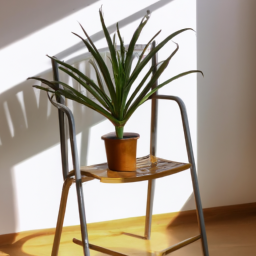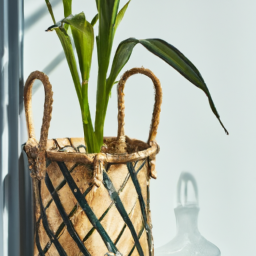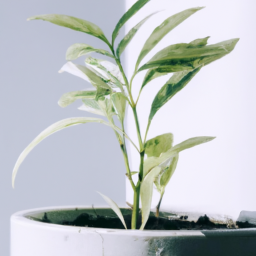
Have you ever wondered, “Should indoor plants be put outside?” It’s a question that many plant enthusiasts ponder, especially when the warmer months roll around. While indoor plants can thrive indoors, there are several reasons why taking them outside can be beneficial. In this blog post, we’ll explore the advantages of giving your indoor plants a taste of the great outdoors and discuss some important considerations to keep in mind. So, if you’re curious about whether your leafy companions would benefit from some time in the sun, keep reading to find out!
Benefits of Moving Indoor Plants Outside
Indoor plants are a great addition to any home or office, providing numerous benefits such as improved air quality and a touch of nature. However, have you ever wondered if it would be beneficial to move your indoor plants outside? In this article, we will explore the advantages of exposing your indoor plants to the great outdoors.
1. Increased Sunlight Exposure
One of the primary benefits of moving indoor plants outside is the increased exposure to sunlight. While indoor lighting can mimic natural light to some extent, nothing beats the real thing. Sunlight provides a full spectrum of light that plants need for photosynthesis, which is essential for their growth and overall health.
When you move your indoor plants outside, they will receive direct sunlight, allowing them to thrive and reach their full potential. This exposure to natural light can result in lusher foliage, vibrant blooms, and stronger stems. So, if you notice your indoor plants looking a bit lackluster, it might be time to give them a taste of the outdoors.
However, it’s important to note that not all indoor plants can tolerate direct sunlight. Some plants, like ferns and peace lilies, prefer indirect light and may suffer from sunburn if exposed to intense sunlight. Before moving your plants outside, research their specific light requirements to ensure they will benefit from the increased sunlight.
2. Enhanced Air Circulation
Indoor environments can sometimes lack proper air circulation, especially if you have limited windows or live in a tightly sealed space. Moving your indoor plants outside can greatly improve air circulation around them. The gentle breeze outdoors helps in the exchange of gases, allowing plants to take in carbon dioxide and release oxygen more efficiently.
Additionally, increased air circulation can prevent the buildup of stagnant air, which can lead to the growth of mold, mildew, or pests. By moving your indoor plants outside, you create a healthier environment for both the plants and the people around them.
However, it’s crucial to acclimate your indoor plants gradually to the outdoor conditions. Sudden exposure to strong winds can damage delicate foliage or uproot plants. Begin by placing your plants in a sheltered spot outdoors and gradually increase their exposure to wind over a few weeks.
3. Natural Pest Control
Indoor plants are not immune to pests, and dealing with infestations can be a constant battle. Moving your plants outside can provide a natural solution to pest control. Outdoors, your plants have access to a whole ecosystem of beneficial insects that prey on common plant pests.
Ladybugs, lacewings, and parasitic wasps are just a few examples of beneficial insects that can help keep your plants pest-free. These insects feed on aphids, mealybugs, spider mites, and other common indoor plant pests, reducing the need for chemical pesticides.
However, it’s important to monitor your plants closely when you move them outside, as they may also attract unwanted pests. Keep an eye out for signs of infestation and take appropriate measures to control any outbreaks.
In conclusion, moving your indoor plants outside can provide numerous benefits, including increased sunlight exposure, enhanced air circulation, and natural pest control. However, it’s crucial to consider the specific needs of your plants and gradually acclimate them to the outdoor conditions. So, if you’re looking to give your indoor plants a breath of fresh air, why not consider taking them outside?

Factors to Consider Before Moving Indoor Plants Outside
Introduction
Indoor plants are a great way to bring nature into your home and enjoy the benefits of greenery all year round. However, there may come a time when you consider moving your indoor plants outside, whether it’s to give them a breath of fresh air or to accommodate their growth. Before making this decision, it’s important to consider a few factors to ensure the well-being and success of your indoor plants in an outdoor environment. In this article, we will discuss the key factors you should consider before moving your indoor plants outside.
1. Light Requirements
The first factor to consider is the light requirements of your indoor plants. While indoor plants are typically accustomed to lower light conditions, outdoor environments offer much brighter and more intense light. Before moving your plants outside, assess the light conditions in your intended outdoor location. Determine whether it receives direct sunlight, partial shade, or full shade throughout the day. Understanding the light levels will help you choose the right plants for the area and avoid exposing your indoor plants to excessive or insufficient light.
When transitioning your indoor plants outside, it’s crucial to acclimate them gradually to the increased light levels. Sudden exposure to intense sunlight can lead to sunburn and leaf damage. Start by placing your plants in a partially shaded area for a few hours each day and gradually increase the duration over a week or two. This process allows your plants to adjust and develop a tolerance to the outdoor light conditions.
2. Temperature and Climate
Another important factor to consider is the temperature and climate of your outdoor environment. Indoor plants are typically grown in controlled environments with stable temperatures. Moving them outside exposes them to the fluctuations and extremes of the natural climate. Different plants have different temperature preferences, so it’s essential to research the specific requirements of your indoor plants.
Before moving your plants outside, check the average temperatures in your region and compare them to the recommended temperature range for your plants. If the outdoor temperatures are too extreme or fall outside the suitable range, it may be best to keep your plants indoors or provide them with temporary outdoor exposure during milder seasons.
Additionally, consider the humidity levels in your area. Indoor environments are often drier than outdoor spaces, so your plants may require additional humidity when placed outside. Regular misting or placing a tray of water near the plants can help maintain the desired humidity levels.
3. Pests and Diseases
When moving your indoor plants outside, you expose them to a whole new range of pests and diseases that may not be present indoors. It’s important to be proactive in preventing and managing these potential issues. Before placing your plants outside, inspect them thoroughly for any signs of pests or diseases. Common pests like aphids, spider mites, and mealybugs can quickly infest your plants and cause damage.
Consider using organic pest control methods or introducing beneficial insects to keep pest populations in check. Regularly monitor your plants for any signs of infestation or disease and take immediate action to prevent further spread. It’s also advisable to keep your outdoor area clean and free from debris that may harbor pests or diseases.
Conclusion
Moving indoor plants outside can be a rewarding experience for both you and your plants, but it requires careful consideration of various factors. Understanding the light requirements, temperature and climate preferences, and potential pest and disease risks will help you make an informed decision and ensure the successful transition of your indoor plants to an outdoor environment. By following these steps and providing the necessary care, your indoor plants can thrive outside and continue to bring beauty and freshness to your surroundings.

Should Indoor Plants Be Put Outside?
Many indoor plant owners often wonder if it is beneficial to move their beloved green friends outdoors. While indoor plants thrive in controlled environments, exposing them to the great outdoors can have numerous advantages. However, it is crucial to follow certain steps to ensure a successful transition. In this article, we will explore three essential tips for successfully transitioning indoor plants to the outdoors.
1. Assessing the Plant’s Suitability for Outdoor Conditions
Before taking your indoor plants outside, it is important to assess their suitability for outdoor conditions. Not all plants are well-suited for outdoor environments, especially if they have been acclimated to indoor conditions for a long time. Here are some factors to consider:
Light Requirements: Determine if your plant requires full sun, partial shade, or full shade. This will help you choose the appropriate outdoor location.
Temperature Tolerance: Some indoor plants are sensitive to extreme temperatures. Research the plant’s temperature preferences and ensure that the outdoor environment is suitable.
Watering Needs: Consider the watering requirements of your plant. Outdoor conditions may affect the plant’s water needs, so it is important to monitor and adjust accordingly.
Once you have assessed these factors, you can determine whether your indoor plant is suitable for outdoor conditions. If you are unsure, consult a plant expert or do further research specific to your plant species.
2. Gradually Introduce the Plant to Outdoor Conditions
Transitioning indoor plants to the outdoors should be done gradually to prevent shock and stress. Sudden exposure to outdoor elements can be overwhelming for plants that have been accustomed to controlled indoor environments. Here’s a step-by-step guide:
Step 1: Start by placing your plant in a shaded outdoor area for a few hours each day. This will help the plant adjust to the increased light intensity and temperature fluctuations.
Step 2: Gradually increase the duration of outdoor exposure over the course of a week or two. Monitor the plant closely for any signs of stress, such as wilting or leaf discoloration.
Step 3: After the acclimation period, your plant should be ready to be placed in its desired outdoor location. Ensure that the spot meets the plant’s light and temperature requirements.
By following this gradual transition process, you give your indoor plant the best chance to adapt to the outdoor conditions successfully.
3. Monitor and Care for the Plant
Once your indoor plant has been moved outside, it is crucial to monitor and care for it diligently. Outdoor conditions can be more unpredictable than indoor environments, and your plant may require additional attention. Here are some tips:
Watering: Outdoor conditions may affect the watering needs of your plant. Monitor the soil moisture regularly and adjust your watering schedule accordingly. Be mindful of rainfall, as excessive water can lead to root rot.
Protection from Pests: Outdoor plants are more susceptible to pests and diseases. Inspect your plant regularly for any signs of infestation or damage. Consider using organic pest control methods to protect your plant.
Seasonal Changes: Outdoor plants experience seasonal changes, which may require adjustments in care. Take note of temperature fluctuations, frost warnings, and other seasonal factors that can impact your plant’s health.
By closely monitoring and providing appropriate care, you can ensure that your indoor plant thrives in its new outdoor home.
In conclusion, transitioning indoor plants to the outdoors can be a rewarding experience for both the plant and the plant owner. By assessing the plant’s suitability, gradually introducing it to outdoor conditions, and monitoring its progress, you can successfully bring your indoor plants outside and watch them flourish in the natural elements.
Essential Points
Indoor plants have become increasingly popular in recent years, adding a touch of greenery and freshness to our homes. But as the seasons change and the weather warms up, many plant enthusiasts find themselves wondering if it’s time to move their beloved indoor plants outside. So, should indoor plants be put outside? Well, it depends on a few factors.
Firstly, it’s important to consider the specific needs of your plants. While some indoor plants thrive in outdoor environments, others may struggle to adapt to the harsher conditions. Factors such as sunlight exposure, temperature fluctuations, and humidity levels should be taken into account. For example, if your indoor plant requires low light and high humidity, it may not fare well outside in direct sunlight and drier air. On the other hand, if your plant is already placed near a window receiving plenty of sunlight, gradually introducing it to the outdoors may be beneficial.
FAQ Compilation:
Q1: Should indoor plants be put outside?
A1: It depends on the specific needs and characteristics of the indoor plant. While some indoor plants can thrive when placed outside, others may not fare well in the outdoor environment. Factors such as temperature, sunlight exposure, humidity, and the plant’s natural habitat should be considered before deciding to move an indoor plant outdoors.
Q2: What are the benefits of putting indoor plants outside?
A2: Placing indoor plants outside can offer several benefits. Firstly, outdoor environments generally provide more natural light, which is essential for photosynthesis and the overall growth of plants. Secondly, outdoor air circulation can help prevent the buildup of stagnant air and potential pest infestations. Lastly, being exposed to natural weather conditions can stimulate the plants’ natural growth cycle and enhance their overall health.
Q3: What precautions should be taken when moving indoor plants outside?
A3: When transitioning indoor plants to an outdoor environment, it’s important to take a few precautions. Gradually introduce the plant to the outdoor conditions by placing it in a shaded area initially and gradually increasing its exposure to sunlight. Additionally, ensure that the outdoor location provides suitable protection from extreme weather conditions, such as strong winds, heavy rain, or intense heat. Regularly monitor the plant for any signs of stress or damage and adjust its placement accordingly.
Q4: Are there any risks associated with moving indoor plants outside?
A4: Yes, there are potential risks involved in moving indoor plants outside. Sudden exposure to direct sunlight or extreme temperature changes can shock the plant and cause damage. Additionally, outdoor environments may harbor pests or diseases that indoor plants are not accustomed to, increasing the risk of infestation or infection. It’s crucial to research and understand the specific needs of each plant before making the decision to move them outdoors.
Q5: Can all indoor plants be placed outside?
A5: Not all indoor plants are suitable for outdoor placement. Some plants are more delicate and may not tolerate outdoor conditions well. It’s important to research the specific needs and requirements of each indoor plant before considering moving them outside. Factors such as temperature tolerance, light requirements, and natural habitat should be taken into account. If unsure, consulting with a local horticulturist or plant expert can provide valuable guidance on whether a specific indoor plant can be safely placed outdoors.

James Wong is a renowned ethnobotanist, plant scientist, and local television presenter. With a passion for demystifying plant science, he is known for translating complex botanical concepts into practical advice for everyday plant enthusiasts. James’s expertise spans from traditional gardening to cutting-edge plant technologies, making his insights accessible and informative.


